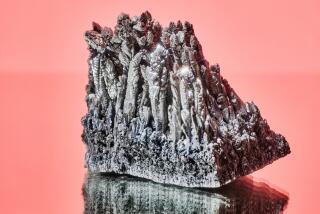Questioning ‘science’ behind miracle cures
- Share via
In the olden days, peddlers of miracle cure-alls traveled from village to village in donkey carts.
Now they use late-night cable TV commercials.
“You need to discover the ancient Japanese secret to perfect health!” declares the perky announcer for Kinoki foot pads, a product that treats diabetes, arthritis, backaches, cellulite, high blood pressure, insomnia, headaches, fatigue and mood changes, according to the commercial.
All you have to do is place the pads on the bottom of your feet before going to bed and the product “naturally draws toxins out of your body as you sleep,” the announcer proclaims.
Physician Peter Pressman can vouch for the fact that Kinoki can bring about a mood change. He wasn’t feeling cheerful recently at 3 a.m. after a series of pages from a hospital nurse.
“I was sitting on the sofa with a bowl of Haagen-Dazs, watching television,” Pressman said, “and on came this Kinoki thing.
“I have to confess that I started giggling uncontrollably.”
Kinoki also has become an object of mirth on the Web, where posters point out inconsistencies. For example, although the commercial speaks of the product’s age-old Japanese origins -- while showing a smiling, kimono-clad woman -- the official Kinoki website says the product is based on ancient knowledge from China.
Well, they’re both in Asia.
But aside from the entertainment value of commercials with wild claims and leaden acting, cure-alls are no laughing matter to Pressman, who has spoken out against them, or to the Federal Trade Commission.
“Usually they list a dozen or so diseases treated by the product,” said Richard Cleland, assistant director of the division of advertising practices at the agency.
“But the diseases don’t have a common, root connection. It’s hard to figure out how such a product could cure them all.”
Xacta 3000 Inc., a Lakewood, N.J., mail-order company that markets and distributes Kinoki, hasn’t been charged by the FTC with any irregularities in regard to the product.
Cleland was familiar with the Kinoki advertisements but declined to discuss the product’s specific claim. The agency never reveals whether advertisements are under investigation, he said.
Xacta 3000’s lawyer didn’t respond to requests for interviews with company executives.
According to court documents in a recent trademark lawsuit filed by the company, Xacta 3000 has been selling detoxification foot pads under the Kinoki name for at least two years. No sales figures were included in the filing.
Cure-alls can be big moneymakers. This year, a federal appeals court in Illinois affirmed that the companies behind the Q-Ray bracelet -- a metal wristband advertised as a cure for back pain, sinus problems, tendinitis, sciatic pain and more -- had to pay as much as $87 million in refunds to customers.
The ads for the bracelet declared that it emitted “q-rays” and enhanced the flow of “bio-energy.”
The court decision in the case called these claims “blather.”
Cleland said it was common for cure-alls to claim some sort of scientific backing.
“They know that if you have a reasonable amount of skepticism, you will say, ‘No way that can work,’ ” he said.
“They have to convince you there is a way, and frequently they do that by making it sound scientific.”
The Kinoki TV ads include a before-and-after “Lab Results” graphic that shows the product eliminating harmful substances from the body.
But there is no identification of the laboratory. It also doesn’t help that alcohol is misspelled as “alchohol” on the chart.
On one corner of the screen, during the ad, the words “FDA Registered” appear. But Rita Chappelle, a spokeswoman for the Food and Drug Administration, said the agency had no listing for Kinoki among its registered nonprescription products.
Animation in the ad shows toxins flowing downward through a tree. The announcer explains: “Just like a tree draws energy in and toxins down its trunk, Kinoki foot pads work the same way.”
Pressman wasn’t impressed.
“The biological leap from a rodent model to a human is so large,” he said, “that to liken a plant to human beings shouldn’t even be dignified by discussion.”
Pressman said he wasn’t closed-minded when it came to alternatives to mainstream medicine. He has taught classes on the topic at USC.
Some of these non-Western treatments, he said, “are grounded in honest-to-God science, like acupuncture, which has tremendous value.”
But he cautioned that products purporting to be cure-alls should be looked upon with a heavy dose of skepticism, even though he finds the notion alluring.
“I would love to have that sort of sweeping power at my command,” Pressman said. “It would make my work a hell of a lot easier.”
--







